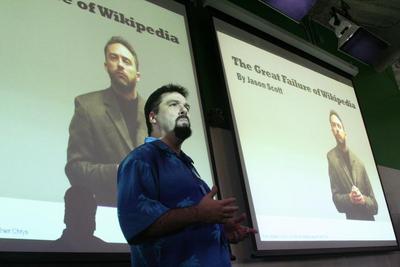10 years ago, I ran an anonymous remailer.
Before I explain it, let me show you the insanely pissed-off message I wrote when I closed it:
*** IMPORTANT NEWS REGARDING HAYSTACK@HOLY.COW.NET ***
The Bovine Remailer, also known as haystack@holy.cow.net, is
hereby CLOSED. Mail sent to that address will bounce; I don’t
know on a technical basis what putting it in the middle of a
remailer chain will do. There are no other remailers or anon
services associated with cow.net.
It has been a fun year, but the simple fact is that running
a remailer is a thankless, embittering, nasty job. For every
success story of alternate or persecuted viewpoints seeing
the light of day, there are another four or five cases of
legal threats, use of the remailer to spam people who have
already turned off access to their accounts from other sources,
and the extremely disturbing trend of posting newsgroups
with falsified From: Headers, intending to cause endless spam
bots to mail the forged address. No one carefully put in a
forged address to endanger or misrepresent another person,
but it was only a matter of time.
Haystack was running on a Sun 3/280 at the cow.net loft. At
the peak, this machine was recieving over one thousand
e-mails a day, doing PGP calculations, and sending them out,
and the 30mhz processor wasn’t up to the task. The final
straw was the use of the remailer to send out several
hundred “MAKE MONEY FAST”-style messages to a group of
folks who then rebelled or retaliated to the remailer itself;
everyone associated in this sucks.
If you think this is a shame, then put up your own remailer;
no doubt you’ll have a thicker skin that the admins of
haystack, and will somehow flourish under the increasingly
fascist and overbearing environment of the Internet, but
the games up here, for now.
Yes, for now. We might return some time in the future,
should technical and financial issues be solved, but it seems
rather unlikely at this juncture.
Once again, if you enjoyed using haystack, you might consider
fighting the good fight and putting up your own. A good,
solid increase in remailers might save the culture. It is
nearly a crime that so much perfectly powerful computer
hardware exists out there, hooked to the net, and a mere
dozen computers, in our case quite aged, were/are doing the
remailing work.
So, well, like we said, it’s been a blast. See you later.
Moo.
– The Haystack Administration.
If that thing makes no sense, that’s fine. I’ll quickly explain it, along with a decade-past perspective on it.
So, way back when on the Internet, people were terrified. By “people”, I mean “White College-Educated Libertarians” and by Internet I mean “The somewhat closed-off-but-with-more-and-more-people-coming network” and by terrified I mean “terrified”.
Anybody who used the Internet for any amount of time knew that there was a good thing going on. You could connect all over the world, you had instantaneous connections, and you had a burst of free speech and transfer of information unlike anything the world had seen. This was what was so cool: you couldn’t over-exaggerate how fucking great it was. You would run out of superlatives before you ran out of Internet.
But part of what made it cool was that it was so free-feeling. Your little favorite idea or fetish, lambasted and marginalized in the world, could flourish and make its own space. Someone could say “fuck” as easily as they said “hello”, and it was all sorts of rough and tumble. This was heady, heady stuff. And there was, therefore, a terrified feeling that it was all going to go away.
Bad things happened back then, and still do. Laws were discussed and proposed that would ruin things. Policy fucks and law fucks and library fucks and academic fucks, all were slowly creeping into some massive shit-ball of dreary clampdown onslaught that was going to take this great Internet out and shoot it.
Bear in mind, of course, I mean the Internet between 1988 and 1995. There was a different Internet before that and a different Internet after that. But thanks to magazines like Wired and Mondo 2000 and all the Ziff-Davis crapshoots, there was this belief that the Internet had, by the early 1990s, achieved a manifest destiny of freedom and wonder that would be unsurpassed in our lifetimes and oh fuck here comes a law.
So in response, people started pushing ways to protect themselves against government and prying eyes and despicable boring people and all the general what-about-the-children types. One way was cryptography and another was anonymity.
Cryptography’s its own mess, but you basically could send pretty-likely-to-be-protected messages, between others, and even more importantly, could generate a hash table indicating that you were receiving an unmolested message, untouched by the government agents who were out to get your crap and make you look bad. If I’m making it sound like a touch of paranoia, well hells yes, this was paranoia. Not your garden variety paranoia with the slight unease of materials and natures you didn’t comprehend, but the even worse paranoia where you knew full well that people were entirely capable of doing crazy monitoring and life-destroying things to you and succeed. So you were paranoid, with some good reason.
Anonymity is the idea that people aren’t free unless you don’t know who they are. Otherwise, they are targets for reprisal, attacks, and general squashing of their ideas and lives. It is, one might say, a necessary vitamin strengthening the body of conversation and knowledge. If people can’t feel they won’t be targeted and pilloried for their statements, the ones they make will be hopelessly crippled and gaunt, lacking in the full force of ideas, like when you say the words ass flap while anonymous and aren’t poked with a stick. Very important, anonymity.
Whoever knew the right people got into Wired magazine and one of the groups who knew someone who knew someone was the “Cypherpunks”, their name a play off “Cyberpunks”, which was dedicated to strong cryptography and a host of other platforms I’m entirely at a loss to recall. Here’s Steven Levy’s big wet kiss to this organization, which is probably the main driving force that I can even remember them. Note that this is the second issue of Wired ever.
So I myself, being a rather young fellow at the time, was totally taken in by these lofty ideals. Promoting freedom and cryptography and anonymity was on my “will do when I can” list that stayed rather dormant through the years when I actually stopped being able to afford to eat regularly. I knew I would one day get regular meals and also be in a position to provide some sort of blow of these cypherpunkish ideals and the rest.
As it turned out, I got the position before I got the regular meals.
The position was running COW.NET, my totally off-the-wall what-the-hell internet service provider I ran from 1995-1998 as a for-profit entity before kicking out of that entirely. I will, more properly, write entries about cow.net’s South Boston period (as opposed to its Quincy period, Medford Period and other Periods) but now let’s dial back to the whole remailer thing.
Cow.net ran on some aging Sun 3/280s. These Suns had cost a bank and an airline $20,000 when they were bought, and I’d paid $300-$500 for them. One of them had come from X.ORG, actually, and I was slow in paying them (SEE: NOT EATING), and they had a whopping 30mhz CPU and 32megs of memory and pushed something like 15-20 amps. Huge, horrible things. And they were connected to the net by a 56k connection. Note, not a modem; a dedicated dropped-in telco line going to an RSU/DSU and the whole expectation we have today with a network room. This cost me roughly $500 a month. It was in a weird location and I was starving and people weren’t buying accounts as fast as I’d have liked but damnit, I was doing it!
So there I was in my position, and I thought I’d better make good on my promises to myself. So I put up an anonymous remailer.
A remailer (in my case, the software was called “mixmaster”) was a program where you could send out e-mail through an e-mail address, which would strip the headers, hold it for a random bit of time, and then blow it out into the world, or another remailer. Eventually, this message would make its way into the world, either posted on a newsgroup or in someone’s e-mail box, and there’d be no way to really trace where it came from.
This is all in theory, of course. Someone who was particularly paranoid could point out that I might be a federal agent, or my lines could be tapped, or someone could hack the box, or …. you know, good solid theoretical breaches. So people would often “chain” remailer stuff, bouncing a message between them, or sending them from anonymous-as-it-could-get-back-then connections and so on. In this way, your precious message and anonymity would be preserved.
What kind of messages would go through?
Oh, it ranged. I know of companies that would give my remailer e-mail address with instructions, so employees could honestly make anonymous suggestions. I know of people who used it to post messages about their medical experience as a doctor without revealing who they were. (Privacy to exploit privacy!) I know of people who threatened each other’s lives….
…oh, did I mention that? See, anything could happen, so naturally folks were assholes. I had someone use the remailer to tell someone that when he gave that speech this Friday, he’d be on a roof with a sniper rifle. I asked my friends what to do, and they suggested “wait until Saturday”. I did. Nobody died.
But this is the crunching-bone reality of these pie in the sky implementations of positive-outlook human interactions: just a dash of dumbass and many come crashing down. Relying on goodwill or a stern talking-to/indication of disappointment upon your shiny new tool being used to poke someone in the eye…. well, it’s what the kids call “full of fail”. You end up with a certain percentage of ass and eventually the ass minority becomes the ass majority and then you are trapped in ass.
So somewhere a year in, I gave up. My machine was being overused by all this, my connection (remember, 56k) was being hosed, and I was being consistently beat up for my actions, those kind of numb-nut rants that only a truly self-righteous somewhat-wronged individual can conceive of. I saw the writing on the wall.
But I’d done the good fight; haystack@holy.cow.net was a heck of a cool e-mail address, the theme of “you are the needle” was clever and in line with the “be revolutionary and fun” idealism I sucked down with a side of fries, and most importantly, I was not sued or arrested.
You can actually do a search to see some of the many fine postings used by the service over the year.
Would I do it again? Oh, likely. I do have ideals of doing the “right thing”, even if it gets a screwdriver in my nose. But either way, I won’t forget my lessons learned anytime soon.
1 Comment

